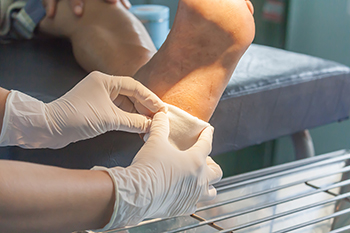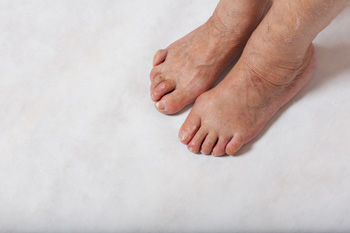

Wounds on the feet can happen for various reasons. Toe injuries, wearing shoes that do not fit correctly, or having diabetes may all contribute to having foot wounds. Diabetic patients can develop neuropathy, and they especially need to be careful of wounds that develop on the feet. This is the inability to feel cuts and scrapes on the feet, and an infection can easily occur. This can lead to getting a foot ulcer, and it is important that immediate medical treatment is sought. A podiatrist will remove dead skin that has formed, which is known as debridement. This is followed by dressing the wound, and antibiotics are often prescribed. Many times, the patient will wear special footwear which may include a boot or custom made orthotics. Diabetes occurs as a result of elevated blood sugar levels, and may be controlled by the foods that are eaten. This may help to reduce the recurrence of wounds on the feet, and regular visits with a podiatrist are strongly suggested. If you have a wound on your foot, please consult with this type of doctor who can treat existing foot wounds, and help you to manage diabetes.
Wound care is an important part in dealing with diabetes. If you have diabetes and a foot wound or would like more information about wound care for diabetics, consult with one of our podiatrists from Grand Blanc Family Footcare. Our doctors will assess your condition and provide you with quality foot and ankle treatment.
What Is Wound Care?
Wound care is the practice of taking proper care of a wound. This can range from the smallest to the largest of wounds. While everyone can benefit from proper wound care, it is much more important for diabetics. Diabetics often suffer from poor blood circulation which causes wounds to heal much slower than they would in a non-diabetic.
What Is the Importance of Wound Care?
While it may not seem apparent with small ulcers on the foot, for diabetics, any size ulcer can become infected. Diabetics often also suffer from neuropathy, or nerve loss. This means they might not even feel when they have an ulcer on their foot. If the wound becomes severely infected, amputation may be necessary. Therefore, it is of the upmost importance to properly care for any and all foot wounds.
How to Care for Wounds
The best way to care for foot wounds is to prevent them. For diabetics, this means daily inspections of the feet for any signs of abnormalities or ulcers. It is also recommended to see a podiatrist several times a year for a foot inspection. If you do have an ulcer, run the wound under water to clear dirt from the wound; then apply antibiotic ointment to the wound and cover with a bandage. Bandages should be changed daily and keeping pressure off the wound is smart. It is advised to see a podiatrist, who can keep an eye on it.
If you have any questions, please feel free to contact our office located in Grand Blanc, MI . We offer the newest diagnostic and treatment technologies for all your foot care needs.

Broken toes are a common injury. They may happen because of a heavy object falling on one or more of the toes, as well as stubbing a toe into a piece of furniture. There is often immediate bruising and swelling, and it can be difficult to move. A bone that protrudes from the skin can look deformed and will need immediate medical attention. If the fracture is severe, as in the preceding description, surgery may be necessary to align the bone back into its proper place. For mild breaks, the buddy taping system is often effective. This is done by taping the affected toe to the toe next to it, which provides the necessary stability as the healing process occurs. If the big toe is broken, some patients need to have it put in a cast for extra support. Using crutches may be recommended and this is helpful in keeping all weight off the affected toe while being able to walk. Severely broken toes may have blood that is trapped under the toenail possibly causing extreme pain. This can require the blood to be drained through a small hole that is made in the nail or it may be necessary to remove the nail. It is suggested that patients who have broken a toe see a podiatrist who can effectively treat this condition, ultimately leading to proper healing.
A broken toe can be very painful and lead to complications if not properly fixed. If you have any concerns about your feet, contact one of our podiatrists from Grand Blanc Family Footcare. Our doctors will treat your foot and ankle needs.
What to Know About a Broken Toe
Although most people try to avoid foot trauma such as banging, stubbing, or dropping heavy objects on their feet, the unfortunate fact is that it is a common occurrence. Given the fact that toes are positioned in front of the feet, they typically sustain the brunt of such trauma. When trauma occurs to a toe, the result can be a painful break (fracture).
Symptoms of a Broken Toe
Generally, it is best to stay off of the injured toe with the affected foot elevated.
Severe toe fractures may be treated with a splint, cast, and in some cases, minor surgery. Due to its position and the pressure it endures with daily activity, future complications can occur if the big toe is not properly treated.
If you have any questions please feel free to contact our office located in Grand Blanc, MI . We offer the newest diagnostic and treatment technologies for all your foot and ankle needs.

Individuals of all kinds can be susceptible to developing stress fractures, which are essentially tiny cracks in the bones. Runners are certainly no exception. These stress fractures are typically caused by repeated trauma of some kind. When a runner develops a stress fracture in their feet, they might be tempted to continue running despite having this condition. It is important to note that doing this can significantly delay the healing process. Additionally, running with a stress fracture might even lead to the development of some alternative foot injury because of an altered running gait to compensate for the pain of the stress fracture. Instead of running with the stress fracture, one might consider temporarily refraining from running and letting the feet heal. Contact a podiatrist today for specific treatment.
Activities where too much pressure is put on the feet can cause stress fractures. To learn more, contact one of our podiatrists from Grand Blanc Family Footcare. Our doctors can provide the care you need to keep your pain free and on your feet.
Dealing with Stress Fractures of the Foot and Ankle
Stress fractures occur in the foot and ankle when muscles in these areas weaken from too much or too little use. The feet and ankles then lose support when walking or running from the impact of the ground. Since there is no protection, the bones receive the full impact of each step. Stress on the feet can cause cracks to form in the bones, thus creating stress fractures.
What Are Stress Fractures?
Stress fractures occur frequently in individuals whose daily activities cause great impact on the feet and ankles. Stress factors are most common among:
Symptoms
Pain from the fractures occur in the area of the fractures and can be constant or intermittent. It will often cause sharp or dull pain with swelling and tenderness. Engaging in any kind of activity which involves high impact will aggravate pain.
If you have any questions please feel free to contact our office located in Grand Blanc, MI . We offer the newest diagnostic and treatment technologies for all your foot and ankle needs.

Several different kinds of foot afflictions can distort how the bones of the feet are supposed to naturally look. Hammertoe is one such foot condition. This condition occurs when a toe is misshapen because it points upward at the middle joint. As a result, the hammertoe resembles a kind of hammer. After visiting a trusted medical professional such as a podiatrist, one can take steps to correct a hammertoe. For example, a hammertoe correction surgical procedure can straighten the toe. During this procedure, joint or bone tissue may be removed to facilitate the straightening of the toe. Also, affected tendons that are causing the bending of the toes might be loosened during this procedure. If you have a hammertoe, contact a podiatrist today to review your options for correcting the condition.
Hammertoe
Hammertoes can be a painful condition to live with. For more information, contact one of our podiatrists from Grand Blanc Family Footcare. Our doctors will answer any of your foot- and ankle-related questions.
Hammertoe is a foot deformity that affects the joints of the second, third, fourth, or fifth toes of your feet. It is a painful foot condition in which these toes curl and arch up, which can often lead to pain when wearing footwear.
Symptoms
Causes
Genetics – People who are genetically predisposed to hammertoe are often more susceptible
Arthritis – Because arthritis affects the joints in your toes, further deformities stemming from arthritis can occur
Trauma – Direct trauma to the toes could potentially lead to hammertoe
Ill-fitting shoes – Undue pressure on the front of the toes from ill-fitting shoes can potentially lead to the development of hammertoe
Treatment
Orthotics – Custom made inserts can be used to help relieve pressure placed on the toes and therefore relieve some of the pain associated with it
Medications – Oral medications such as anti-inflammatories or NSAIDs could be used to treat the pain and inflammation hammertoes causes. Injections of corticosteroids are also sometimes used
Surgery – In more severe cases where the hammertoes have become more rigid, foot surgery is a potential option
If you have any questions please contact our office located in Grand Blanc, MI . We offer the newest diagnostic and treatment technologies for all your foot and ankle needs.